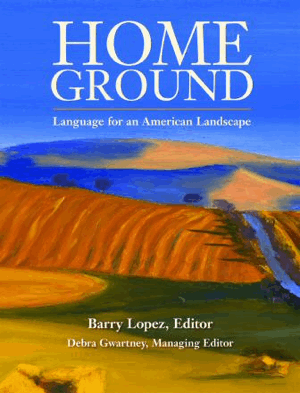The Language of Landscape
Air Date: Week of March 4, 2011

Home Ground: Language for an American Landscape, edited by Barry Lopez and Debra Gwartney. (Courtesy of Trinity University Press)
Living on Earth continues its series exploring features of the American landscape, based on the book Home Ground: Language for an American Landscape, edited by Barry Lopez and Debra Gwartney. In this installment, writer Donna Seaman explains the term "slough."
Transcript
GELLERMAN: By the way - if you're wondering what a "slough†(spelled S-L-O-U-G-H) is, we have a definition for you.
[Daniel Lanois “ O Marie†from Acadie (Red Floor Records 2008).]
The definition comes from the book “Home Ground: Language for an American Landscape,†edited by Barry Lopez and Debra Gwartney. Writer Donna Seaman has this explanation of the term "slough."
SEAMEN: Slough. A slough - or a “sloe†- is a narrow stretch of sluggish water in a river channel inlet or pond. A slough can also be a marsh, swamp, bayou or any soft, muddy or waterlogged ground. The great, flat city of Chicago is built on filled sloughs or swampy bottomland. Slough is also a verb, meaning to mire in a slough or swamp. And to be sloughed can mean lost in a swamp.

Home Ground: Language for an American Landscape, edited by Barry Lopez and Debra Gwartney. (Courtesy of Trinity University Press)
Used as slang - to “slough in†or “slough up†is to arrest or imprison, to be inhibited or bogged down. 19th century travelers reported horses sinking up to their necks in sloughs that look no deeper than a puddle. Prairies, especially those radiating from the Mississippi, are, or were, riddled with sloughs; and sloughs run along the St. Paul, Pacific and Sioux City Railroad tracks, and other elevated rights-of-way, providing ideal homes for muskrats.
GELLERMAN: Writer Donna Seaman calls "the beautiful Hudson Valley in New York State" her home ground. Her definition of slough came from the book “Home Ground,†edited by Barry Lopez and Debra Gwartney.
Links
Living on Earth wants to hear from you!
Living on Earth
62 Calef Highway, Suite 212
Lee, NH 03861
Telephone: 617-287-4121
E-mail: comments@loe.org
Newsletter [Click here]
Donate to Living on Earth!
Living on Earth is an independent media program and relies entirely on contributions from listeners and institutions supporting public service. Please donate now to preserve an independent environmental voice.
NewsletterLiving on Earth offers a weekly delivery of the show's rundown to your mailbox. Sign up for our newsletter today!
 Sailors For The Sea: Be the change you want to sea.
Sailors For The Sea: Be the change you want to sea.
 The Grantham Foundation for the Protection of the Environment: Committed to protecting and improving the health of the global environment.
The Grantham Foundation for the Protection of the Environment: Committed to protecting and improving the health of the global environment.
 Contribute to Living on Earth and receive, as our gift to you, an archival print of one of Mark Seth Lender's extraordinary wildlife photographs. Follow the link to see Mark's current collection of photographs.
Contribute to Living on Earth and receive, as our gift to you, an archival print of one of Mark Seth Lender's extraordinary wildlife photographs. Follow the link to see Mark's current collection of photographs.
 Buy a signed copy of Mark Seth Lender's book Smeagull the Seagull & support Living on Earth
Buy a signed copy of Mark Seth Lender's book Smeagull the Seagull & support Living on Earth

